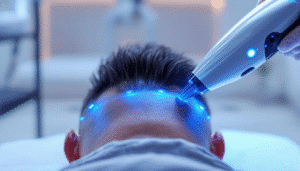Understanding Hair Loss and Its Impact
Hair loss, whether caused by male or female pattern baldness, androgenetic alopecia, or medical conditions like alopecia areata, affects millions worldwide. Hair loss not only impacts physical appearance but also emotional well-being. Factors such as the hair growth cycle, scalp irritation, and even immune system irregularities contribute to further hair loss. For individuals experiencing thinning hair or bald spots, finding effective hair loss treatments becomes a priority. Many individuals lose hair due to various factors, and managing this condition often requires a combination of treatments.
Causes of Hair Loss

Hair loss can be caused by a combination of factors, including hormonal imbalances, genetics, and other underlying medical conditions. Understanding the underlying causes of hair loss is crucial in developing an effective treatment plan.
Hormonal Imbalance
Hormonal imbalances, particularly an excess of androgens, can significantly contribute to hair loss. Androgens, such as testosterone and dihydrotestosterone (DHT), can cause hair follicles to shrink, leading to thinner and shorter hair.
This process, known as miniaturization, is a common cause of hair thinning and baldness. Conditions like polycystic ovary syndrome (PCOS), thyroid disorders, and menopause can disrupt hormonal balance, exacerbating hair loss. Addressing these hormonal issues is essential for effective hair loss treatment and stimulating hair growth.
Genetics
Genetics play a pivotal role in hair loss, especially in cases of androgenetic alopecia. This hereditary condition, often referred to as male or female pattern baldness, is passed down from one’s parents and results in hair loss due to the sensitivity of hair follicles to androgens. Genetic hair loss can begin as early as puberty and tends to progress over time, leading to noticeable thinning and bald spots. Understanding the genetic predisposition to hair loss can help in tailoring personalized treatment plans that target the root cause.
Medical Conditions
Underlying medical conditions can also contribute to hair loss. Autoimmune disorders such as alopecia areata cause the immune system to attack hair follicles, leading to patchy hair loss. Scalp infections, such as fungal infections, can weaken the scalp’s health and cause hair to fall out. Chronic illnesses, including diabetes and high blood pressure, may also impact hair growth due to reduced blood supply to hair follicles.
Stress and Lifestyle Factors
Chronic stress can disrupt the hair growth cycle, pushing more hair into the shedding phase (telogen effluvium). Poor nutrition, including deficiencies in iron, zinc, and vitamins like B12 and D, can weaken hair shafts and reduce overall hair thickness. Smoking, excessive alcohol consumption, and lack of sleep further exacerbate hair loss by negatively affecting blood circulation and scalp health.
Environmental Factors
Exposure to pollutants, harsh chemicals, and UV radiation can damage hair follicles and scalp tissue. Frequent use of chemical treatments and heat styling tools weakens the hair shaft, causing breakage and thinning over time.
Aging
As people age, hair naturally becomes thinner due to a decrease in the number of active hair follicles. The hair growth cycle slows down, and the scalp produces less oil, leading to brittle hair that is prone to shedding. Aging can also exacerbate existing conditions like androgenic alopecia, making hair loss more apparent.
Stem Cell Therapy for Hair Loss: A Revolutionary Approach

How Stem Cells Work in Hair Restoration
Stem cells, specifically mesenchymal stem cells derived from adipose tissue, have emerged as a groundbreaking solution for hair restoration. Stem cell therapy for hair loss leverages the regenerative power of these cells to stimulate hair growth, repair damaged hair follicles, and encourage the regrowth of new hair.
Unlike traditional treatments like platelet-rich plasma (PRP) or low-level laser therapy, stem cell therapy directly addresses the root cause of hair shedding by promoting the health and functionality of human hair follicles. The role of hair follicle stem cells is crucial in these mechanisms, as they are directly involved in the regeneration and health of hair follicles.
Stem Cell Hair Transplant: A Modern Method
Stem cell hair transplant is a cutting-edge procedure combining the principles of hair transplantation with stem cell therapy. This involves harvesting hair follicles from a donor area, processing them to extract stem cells, and injecting them back into areas of thinning hair or bald spots. This treatment improves hair density and stimulates the anagen phase of the hair growth cycle, leading to the appearance of thicker and healthier hair.
Types of Hair Loss and Suitable Treatments
Androgenetic Alopecia
Also known as male or female pattern baldness, androgenetic alopecia is one of the most common causes of hair loss. It is characterized by a receding hairline, hair thinning, and a reduction in hair shaft thickness. Stem cell therapy and hair transplantation have proven effective in addressing this condition by stimulating new hair growth and preserving existing hair.
Alopecia Areata
This autoimmune disorder leads to sudden hair loss in patches. Stem cell therapy for hair loss may help by modulating the immune system and encouraging hair regrowth in affected areas.
Female Pattern Hair Loss
Female pattern hair loss is a progressive condition causing diffuse thinning across the scalp. Treatments like stem cell therapy, combined with other medications, can significantly improve hair regrowth and restore hair density in women.
Comparing Stem Cell Therapy to Traditional Hair Loss Treatments
Platelet-Rich Plasma (PRP)
While PRP has gained popularity for its ability to treat hair loss, it relies on stimulating existing hair follicles rather than regenerating new ones. Stem cell therapy, on the other hand, enhances the scalp’s regenerative capacity, leading to long-lasting results.
Follicular Unit Transplantation (FUT) and Follicular Unit Extraction (FUE)
Surgical procedures like FUT and FUE involve transplanting hair from a donor area to areas of hair loss. When combined with stem cell therapy, these methods can optimize the outcome by improving the health of transplanted hair and surrounding follicles.
Over-the-Counter Medications and Other Treatments
Many over-the-counter products claim to treat hair loss but often lead to unwanted hair growth in unintended areas or cause allergic reactions. Stem cell-based treatments offer a more targeted and effective solution without these side effects.
Limitations of Traditional Solutions

Invasive Procedures
Hair transplantation, including methods like Follicular Unit Transplantation (FUT) involves surgically transplanting healthy hair follicles from one part of the body to another. While FUT procedures can be effective, they are invasive more invasive and require a significant amount of downtime and financial investment.
Moreover, hair transplants may not be suitable for everyone, particularly those with extensive hair loss or insufficient donor hair.
Medications like minoxidil and finasteride are commonly used to treat hair loss. However, these treatments come with potential side effects and may not be effective for all individuals. Continuous use is often necessary to maintain results, which can be inconvenient and costly over time.
In contrast, stem cell hair restoration offers a non-invasive alternative that leverages the body’s own regenerative capabilities to stimulate hair growth.
This type of treatment has time and time again shown promising results in clinical trials, providing a more natural and sustainable solution for hair loss. By focusing on the health and functionality of hair follicles, stem cell therapy addresses the root cause of hair loss, offering a long-term solution without the drawbacks of traditional methods.
Clinical Trials and FDA Approval

Stem cell therapy for hair loss is backed by ongoing clinical trials exploring its efficacy and safety. While still awaiting full FDA approval for specific hair restoration applications, preliminary results are promising, with many healthcare professionals considering it the future of hair restoration.
Factors Affecting Hair Restoration Success
The success of stem cell therapy and other treatments depends on several factors:
Severity of Hair Loss: Individuals with significant hair shedding may require multiple sessions.
Type of Hair Loss: Conditions like androgenic alopecia or female pattern baldness respond better to certain therapies.
Scalp Health: A healthy scalp provides an optimal environment for hair regrowth.
Blood Supply: Adequate blood flow is crucial for nourishing hair follicles and stimulating growth.
Why Stem Cell Therapy Stands Out
Stem cell therapy’s ability to regenerate human hair follicles and stimulate the hair growth cycle makes it a superior choice for those seeking long-term solutions. It treats baldness at the cellular level, addressing factors like the dermal papilla, hair shaft thickness, and scalp rejuvenation. This innovative approach not only restores lost hair but also improves overall hair health.
Conclusion
For individuals struggling with hair loss, stem cell therapy offers a scientifically advanced and highly effective solution. By encouraging hair growth, improving hair density, and addressing underlying causes, stem cell-based treatments represent a significant leap forward in hair restoration.
Whether you’re dealing with male or female pattern hair loss, alopecia areata, or thinning hair, consulting a healthcare provider about receiving treatment can help you achieve new hair growth and regain confidence. With advancements in clinical trials and techniques, the future of hair restoration is brighter than ever.

